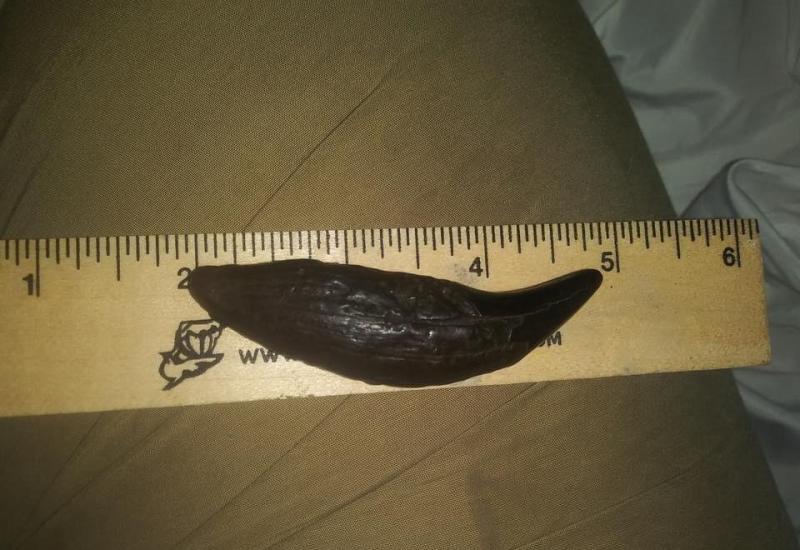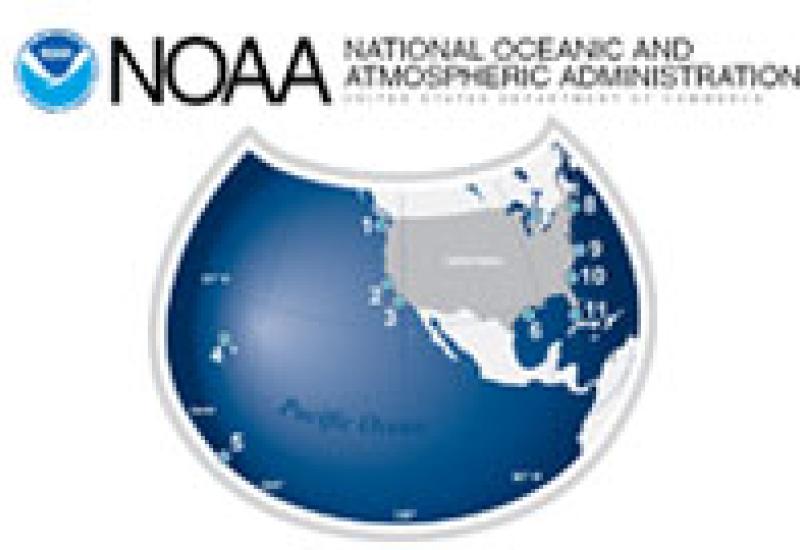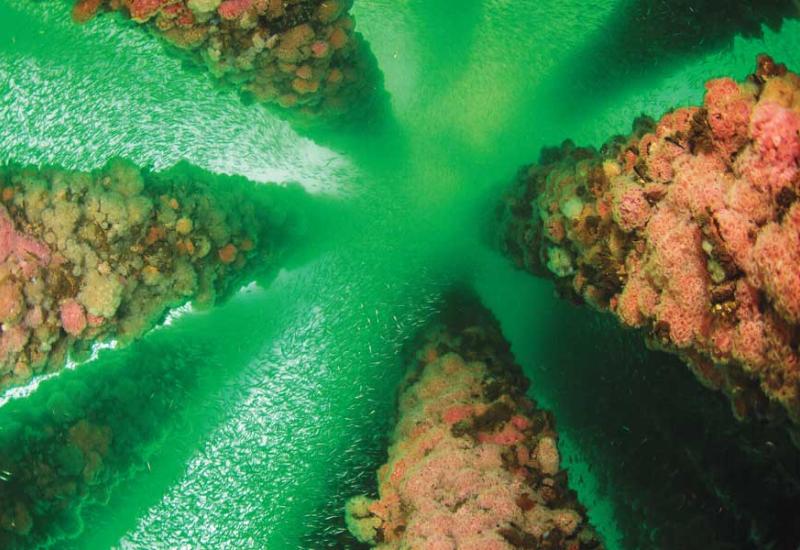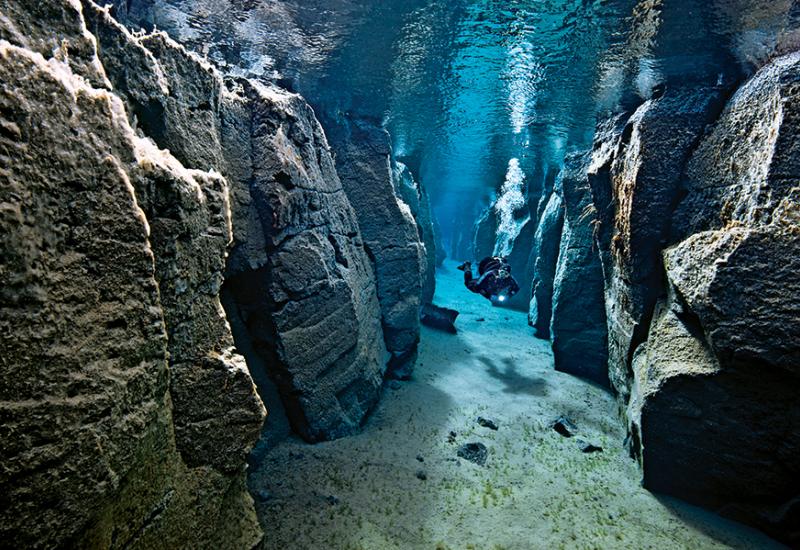Gulf Coast Rigs
March 2008
By Jesse Cancelmo
Imagine an archipelago of 4,000 tiny islands scattered across an area the size of the Mediterranean Sea. Now, picture each islet hosting a thriving population of tropical fish, sponges and corals. Did I mention these islands are made of steel? They were built by petroleum companies to tap underwater energy supplies. But below the waterline, Mother Nature morphed the metal structures into living reefs, now thriving with tropical marine life.
These platforms occupy a stretch of 500 miles of ocean from the Texas-Mexico border east to the tiny, fishing and oil-patch service town of Venice, La. Some are close to shore in 60 to 120 feet of water while others are more than 100 miles off the coast, in depths of 400 to 1,000 feet or more. But best of all about these mechanized yet alluring islands is their proximity to shore. No passports or airport security checks are needed to get to the northern Gulf of Mexico's extraordinary artificial reefs, which offer rich rewards for every kind of diver.
In some areas of the Gulf, "spearos" and other sportfishers are locked and cocked in pursuit of a grilled seafood dinner as they take aim at red snapper, cobia, king mackerel and other tasty fish. In other spots, photographers are in macro-heaven, focusing their lenses on the flamboyant, orange-spotted tessellated blennies populating the empty barnacles riddling the rigs' metal beams.
And throughout the Gulf, divers into fish ID fill their slates without having to swim very far. Schools of Atlantic spadefish and glittery lookdowns mesmerize reef-watchers by fluttering and swirling around the steel framework of the rigs, while triggerfish, blue tangs and cocoa damselfish browse closer to the jackets--the legs of the metal structures--and beams. Barracudas and jacks swim near the rigs' centers and spiny lobsters and octopus hide out in corners of the framework.
High Island 389
This magnificent rig, a mile from the Flower Garden Banks National Marine Sanctuary's East Flower Garden Bank mooring, is one of my all-time favorite dives. Live-aboard dive boats like the M/V Fling and the M/V Spree normally offer at least one rig dive on their runs from Freeport, Tex., to the three sanctuary reefs. High Island 389 is situated in 400 feet of cobalt blue sea and flaunts iridescent blue tube sponges and bright-red encrusting sponges along with a dense cover of white, fuzzy hydroids and octocorals. Spanish hogfish, puffers and angelfish flit and flutter around the struts and columns. The visibility here often exceeds 100 feet, and the wildlife encounters range from tiny seaweed blennies to eight-foot silky sharks. There's at least one resident loggerhead turtle at 389, and whale sharks cruise through from time to time.
MP 299
Unlike other Louisiana and Texas Gulf ports, the deep-water drop-off here is very close to shore. And this rig--part of the Main Pass (MP) Block, about 25 miles offshore from Venice, La.--is in clean, blue water, unaffected by the Mississippi River's muddy outflow.
I notice something very different on my first descent, compared to the many other rigs I've dived in Texas--at 30 feet, the beams and major braces are totally matted with bright yellow and orange tubastrea cup corals. The golden-covered structure pulsates with life and looks electrified against the cobalt backdrop. While blennies play hide and seek in empty barnacle shells and cocoa damselfish circle the beams, a pair of yellow-mouth groupers keep their eyes on me. An ever-skittish red-spotted hawkfish flies from spot to spot, never resting for more than a couple of seconds, and sergeant majors hyperactively scurry around the columns, defending their turf.
Vermillion 171A
On the run into Vermillion Bay from a dock off a country road in Cypremort Point State Park, the six-pack charter I'm aboard passes by Marsh Island, an undeveloped barrier marine oasis that supports a wildlife refuge for birds. From the western Louisiana shore, it's only a giant stride away from the Gulf of Mexico's wildlife. A few miles in, the scenery turns industrial as we navigate through drilling rigs and production platforms.
Forty miles from shore the charter ties up to Vermillion 171A rig, set in 90 feet of water. Underwater, a cavalcade of silvery shapes comes into view, moving fast toward me. First, it's schooling Atlantic spadefish who, at the last second, veer off like Blue Angel pilots buzzing a packed stadium. Next, a humongous school of dainty lookdowns rushes through the bubbles. Lookdowns always maintain a super-tight formation to confuse predators, and I notice these are juveniles because they're sporting long, wispy dorsal streamers. While I drop deeper down, a powerful school of crevalle jacks swirls by, ripping a course along the structure's perimeter--but seconds later, they disappear. It's all part of another great dive adventure on another mighty rig.
Dive In: Gulf of Mexico Oil Rigs
Getting Around: Freeport, Texas--an 87-mile, two-hour drive south of Houston--is where live-aboards head to the Flower Garden Banks National Marine Sanctuary. From Houston, follow Rte. U.S. 59 to Route TX 288. Access is also available from South Padre Island. Venice, La., is 83 miles and about a two-hour drive southeast of New Orleans on Rte. U.S. 90 and Rte. LA 23 South. Cypremort Point State Park is a 135-mile, three-hour drive west of New Orleans, on Interstates 10 and 310, Rte. U.S. 90 and three state routes.
Dive Conditions: Summer water temps average between 80 and 84 degrees, and visibility ranges from 40 to 60 feet at near-shore rigs, 100 feet at offshore platforms. Near Venice, La., close-in rigs can have less than 40 feet of vis or greater than 100 feet. Winter water temps drop to the low to high 60s. Currents are generally easiest from mid-July through September. Always rig dive with gloves and full body protection, as barnacles are razor-sharp. Stay inside the envelope of the rig to avoid getting swept away by currents.
Dive Plan: One-day trips generally depart in the morning and return the same evening. Two- to three-day trips generally depart in the evening and offer up to five dives the following day(s).
Dive Outfitters, Charters and Education Centers: Gulf Diving, Freeport Tex., www.gulf-diving.com; Ultra Dive, Galveston and Freeport, Tex., www.ultradive.com; American Diving South Padre Island, Tex., www.divesouthpadre.com; True Blue Watersports, Lake Charles, La., www.truebluewatersports.com; Troy Wetzel, Venice, La., www.captaintroywetzel.com. You can also arrange rig dives from other charters or your own private boat. Ask beforehand about sportfishing regulations.
March 2008
By Jesse Cancelmo
Imagine an archipelago of 4,000 tiny islands scattered across an area the size of the Mediterranean Sea. Now, picture each islet hosting a thriving population of tropical fish, sponges and corals. Did I mention these islands are made of steel? They were built by petroleum companies to tap underwater energy supplies. But below the waterline, Mother Nature morphed the metal structures into living reefs, now thriving with tropical marine life.
These platforms occupy a stretch of 500 miles of ocean from the Texas-Mexico border east to the tiny, fishing and oil-patch service town of Venice, La. Some are close to shore in 60 to 120 feet of water while others are more than 100 miles off the coast, in depths of 400 to 1,000 feet or more. But best of all about these mechanized yet alluring islands is their proximity to shore. No passports or airport security checks are needed to get to the northern Gulf of Mexico's extraordinary artificial reefs, which offer rich rewards for every kind of diver.
In some areas of the Gulf, "spearos" and other sportfishers are locked and cocked in pursuit of a grilled seafood dinner as they take aim at red snapper, cobia, king mackerel and other tasty fish. In other spots, photographers are in macro-heaven, focusing their lenses on the flamboyant, orange-spotted tessellated blennies populating the empty barnacles riddling the rigs' metal beams.
And throughout the Gulf, divers into fish ID fill their slates without having to swim very far. Schools of Atlantic spadefish and glittery lookdowns mesmerize reef-watchers by fluttering and swirling around the steel framework of the rigs, while triggerfish, blue tangs and cocoa damselfish browse closer to the jackets--the legs of the metal structures--and beams. Barracudas and jacks swim near the rigs' centers and spiny lobsters and octopus hide out in corners of the framework.
High Island 389
This magnificent rig, a mile from the Flower Garden Banks National Marine Sanctuary's East Flower Garden Bank mooring, is one of my all-time favorite dives. Live-aboard dive boats like the M/V Fling and the M/V Spree normally offer at least one rig dive on their runs from Freeport, Tex., to the three sanctuary reefs. High Island 389 is situated in 400 feet of cobalt blue sea and flaunts iridescent blue tube sponges and bright-red encrusting sponges along with a dense cover of white, fuzzy hydroids and octocorals. Spanish hogfish, puffers and angelfish flit and flutter around the struts and columns. The visibility here often exceeds 100 feet, and the wildlife encounters range from tiny seaweed blennies to eight-foot silky sharks. There's at least one resident loggerhead turtle at 389, and whale sharks cruise through from time to time.
MP 299
Unlike other Louisiana and Texas Gulf ports, the deep-water drop-off here is very close to shore. And this rig--part of the Main Pass (MP) Block, about 25 miles offshore from Venice, La.--is in clean, blue water, unaffected by the Mississippi River's muddy outflow.
I notice something very different on my first descent, compared to the many other rigs I've dived in Texas--at 30 feet, the beams and major braces are totally matted with bright yellow and orange tubastrea cup corals. The golden-covered structure pulsates with life and looks electrified against the cobalt backdrop. While blennies play hide and seek in empty barnacle shells and cocoa damselfish circle the beams, a pair of yellow-mouth groupers keep their eyes on me. An ever-skittish red-spotted hawkfish flies from spot to spot, never resting for more than a couple of seconds, and sergeant majors hyperactively scurry around the columns, defending their turf.
Vermillion 171A
On the run into Vermillion Bay from a dock off a country road in Cypremort Point State Park, the six-pack charter I'm aboard passes by Marsh Island, an undeveloped barrier marine oasis that supports a wildlife refuge for birds. From the western Louisiana shore, it's only a giant stride away from the Gulf of Mexico's wildlife. A few miles in, the scenery turns industrial as we navigate through drilling rigs and production platforms.
Forty miles from shore the charter ties up to Vermillion 171A rig, set in 90 feet of water. Underwater, a cavalcade of silvery shapes comes into view, moving fast toward me. First, it's schooling Atlantic spadefish who, at the last second, veer off like Blue Angel pilots buzzing a packed stadium. Next, a humongous school of dainty lookdowns rushes through the bubbles. Lookdowns always maintain a super-tight formation to confuse predators, and I notice these are juveniles because they're sporting long, wispy dorsal streamers. While I drop deeper down, a powerful school of crevalle jacks swirls by, ripping a course along the structure's perimeter--but seconds later, they disappear. It's all part of another great dive adventure on another mighty rig.
Dive In: Gulf of Mexico Oil Rigs
Getting Around: Freeport, Texas--an 87-mile, two-hour drive south of Houston--is where live-aboards head to the Flower Garden Banks National Marine Sanctuary. From Houston, follow Rte. U.S. 59 to Route TX 288. Access is also available from South Padre Island. Venice, La., is 83 miles and about a two-hour drive southeast of New Orleans on Rte. U.S. 90 and Rte. LA 23 South. Cypremort Point State Park is a 135-mile, three-hour drive west of New Orleans, on Interstates 10 and 310, Rte. U.S. 90 and three state routes.
Dive Conditions: Summer water temps average between 80 and 84 degrees, and visibility ranges from 40 to 60 feet at near-shore rigs, 100 feet at offshore platforms. Near Venice, La., close-in rigs can have less than 40 feet of vis or greater than 100 feet. Winter water temps drop to the low to high 60s. Currents are generally easiest from mid-July through September. Always rig dive with gloves and full body protection, as barnacles are razor-sharp. Stay inside the envelope of the rig to avoid getting swept away by currents.
Dive Plan: One-day trips generally depart in the morning and return the same evening. Two- to three-day trips generally depart in the evening and offer up to five dives the following day(s).
Dive Outfitters, Charters and Education Centers: Gulf Diving, Freeport Tex., www.gulf-diving.com; Ultra Dive, Galveston and Freeport, Tex., www.ultradive.com; American Diving South Padre Island, Tex., www.divesouthpadre.com; True Blue Watersports, Lake Charles, La., www.truebluewatersports.com; Troy Wetzel, Venice, La., www.captaintroywetzel.com. You can also arrange rig dives from other charters or your own private boat. Ask beforehand about sportfishing regulations.










